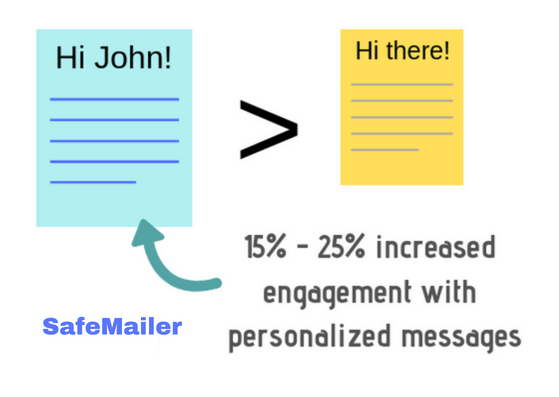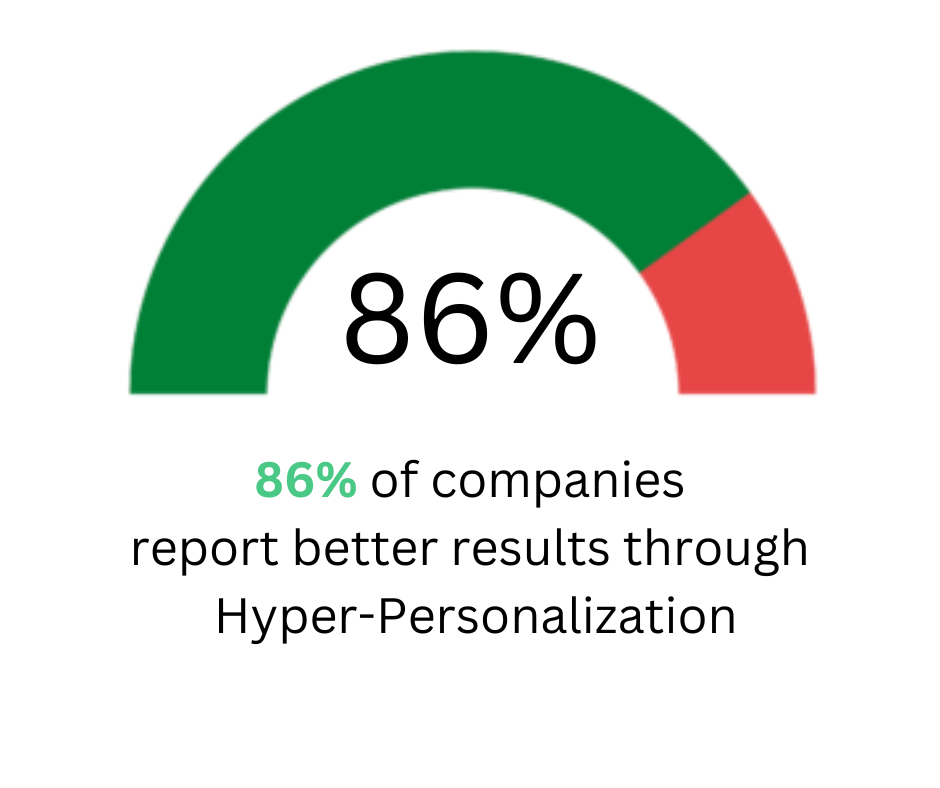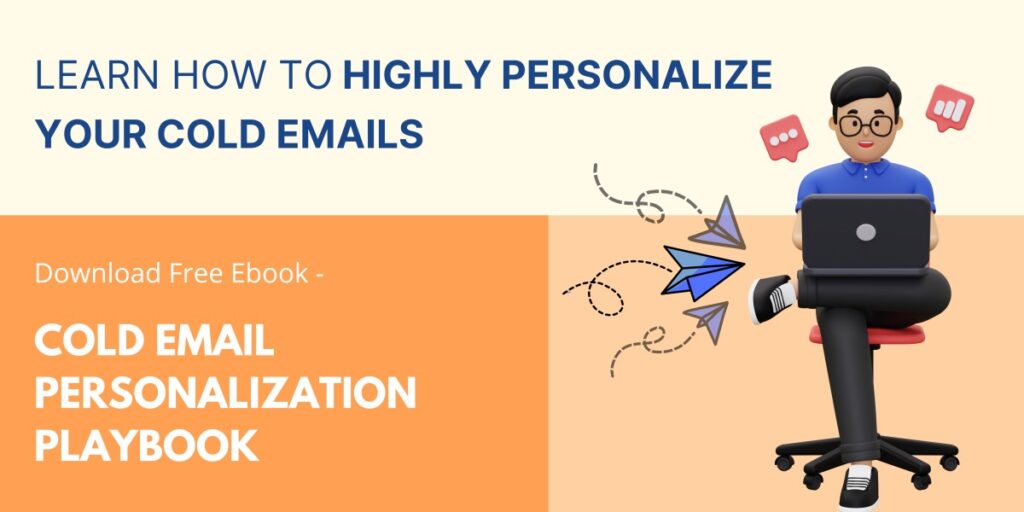To ensure your cold emails generate a return on investment and reach your outreach goals, it is crucial to avoid spammy and robotic approaches that end up in the junk folder and cold email personalization is the key.

By personalizing your emails, you can make them more engaging, relevant, and worth replying to.
This not only enhances the chances of your emails being read but also improves their overall deliverability, ensuring they reach the recipients’ primary inboxes instead of getting filtered out as spam.
What is cold email personalization?
When people think of personalization in cold email campaigns, they often associate it with simply adding the prospect’s first and last name. However, personalization goes far beyond that basic level of customization.
In many mass cold email campaigns, generic merge tags like {{first_name}} and {{last_name}} are used, resulting in a lack of true personalization.
To personalize effectively, you need to write customized text that shows the person you’ve done the research with and genuinely want to catch their attention.
This includes incorporating details such as your prospect’s previous work (blogs, articles, e-books, etc.), clients they’ve worked with, the software they use, their marketing activities, interests, and more.
Incorporating these personalized elements can help you make a big difference in the success of your email campaign.
Why is personalization important for cold emails?
Personalization is crucial to the success of your email campaigns especially when it comes to cold emailing.
Adding a personal touch to your emails can make a world of difference. It’s like the secret sauce that can boost your open rates and get your prospects more engaged.
When you personalize your cold emails, you tailor them specifically to each recipient. You can mention mutual connections or shared interests, and even give compliments on the content they’ve created. This kind of personalization helps build trust and rapport with your prospects, which means they’re more likely to respond to your email.
And here’s another cool thing about personalization: it allows you to speak directly to the individual. By using language that resonates with them, you increase the chances of them actually engaging with your content. It’s all about making that connection and showing that you understand their needs and interests.
Importance of Segmentation for Boosting Cold Email Personalization Success
Effective communication is vital for businesses to connect with their target audience. Cold email campaigns can be powerful, but generic emails don’t cut it. That’s where segmentation and personalization come in.
Personalizing emails based on segments helps you boost your open and click-through rates. However, despite understanding its importance, many marketers struggle to implement effective segmentation. A systematic approach can help you here.
By defining your campaign goals, collecting relevant data, and using conditional logic to assign subscribers to segments you will be able to segment your list appropriately.
Then use these segments to craft personalized subject lines, customize email content, and automate with dynamic content and merge tags and enjoy the success of your campaign.
Advanced techniques to personalize your cold emails
You will see your name in every subject line today. So, how can you stand out and connect with your recipients?
Hyper-personalization is the key. It helps you craft tailored messages that capture attention and build rapport.
In fact a statistic from transmyt show that,

The tips for email personalization beyond the first name include:
Location-based personalization:
Customize emails by mentioning the recipient’s city or region in the subject line or content. Offer exclusive deals relevant to their location to make the emails more relevant and tailored.
Purchase history personalization:
Use past purchase history to recommend related products or offer exclusive discounts to loyal customers. Create a personalized shopping experience based on their buying patterns.
Celebrate special occasions:
Send personalized emails to subscribers on their birthdays or anniversaries. Wish them and offer special discounts, gifts, or exclusive access to celebrate with your brand.
Analyze user behavior:
Track engagement patterns, such as open rates and click-through rates, and preferences of subscribers. Segment the email list based on this data to target recipients more effectively with content that aligns with their interests.
Industry-based personalization:
If you have insights into subscribers’ professional backgrounds, tailor the content specifically to their industry. Address their unique challenges, offer industry-specific solutions, and showcase how your product or service can help them.
Leverage social media for personalization:
Gather insights from subscribers’ social media profiles, such as interests or recent posts, and incorporate that knowledge into email personalization. Refer to their social media activity to add a personal touch and enhance engagement.
What is Account-Based Personalization?
Sending generic emails won’t cut it anymore. That’s where account-based personalization (ABP) comes in. ABP focuses on tailoring your marketing efforts to specific target accounts, rather than individual leads or contacts.
Incorporating ABP will serve several benefits involving a targeted approach, accelerated buyer’s journey, better customer relationships, qualitative data, a personalized experience, improved ROI, and quicker sales cycles.
So, embrace the power of account-based personalization and unlock the full potential of personalized marketing in your email campaigns.
Mistakes you should avoid while personalizing your cold emails
Email personalization can work only if done correctly. Hence, it’s important to avoid common email personalization mistakes that can undermine its effectiveness.
Here are some common mistakes that can hinder the effectiveness of email personalization:
Operating without an overall email personalization strategy:
Having a well-defined strategy is crucial to ensure relevance and consistency in personalized messages. It involves segmentation, data collection, dynamic content, and testing and optimization.
Sending a message with a bad variable name:
Mistakenly sending emails with placeholder variables instead of personalized information can harm the relationship with subscribers. Best practices include using clear, concise, and relevant variable names, sending test emails, and using easy-to-understand naming conventions.
Sending a blank value:
Sending emails with empty fields instead of personalized information makes messages appear generic and careless. Prevent this by implementing robust data validation processes, reviewing and updating data collection methods, and setting up safeguards to identify and exclude incomplete data.
Over-segmenting your customer base:
While segmentation is important, over-segmentation can reduce engagement and campaign effectiveness. Find a balance between segmentation and audience size by defining segments based on relevant criteria and regularly evaluating and refining them.
Sending to an incorrect segment:
Sending personalized emails to the wrong segment can damage your brand’s reputation. Implement quality assurance processes, define segment criteria clearly, and regularly review and update segment definitions.
Irrelevant product recommendations:
Offering tailored product recommendations is a benefit of email personalization, but sending unrelated recommendations can lead to disengagement. Analyze customer behavior and preferences to provide accurate and relevant recommendations.
Sending at the wrong time:
The timing of email delivery greatly affects its success. Analyze audience behavior patterns and preferences to determine the best time to send emails. Experiment with different send times and days and measure their impact on engagement metrics.
How personalized cold emails can help you boost your response rates?
Personalization plays a significant role in increasing email response rates. Here are eight effective email personalization examples to boost response rates.
- Using customers’ first names: Addressing customers by their first names creates familiarity and shows that they are seen as individuals.
- Crafting descriptive and intriguing subject lines: Subject lines have a significant impact on open rates, so creating attention-grabbing personalized subject lines is crucial.
- Personalizing the “From” field and the “To” field: Customizing the sender name and using the recipient’s name in the “To” field adds a personal touch and increases the likelihood of engagement.
- Including tangible items: Adding physical elements like discount codes, exclusive offers, or free samples creates excitement and engagement.
- Incorporating prospect-specific content: Segmenting the email list based on demographics, preferences, or purchase history allows for targeted content that addresses each segment’s needs.
- Using dynamic content: Dynamic content adapts to each recipient’s preferences, location, or past interactions, making the emails more engaging and relevant.
- Leveraging customer conversions: Utilizing information gathered from customer actions on the website, such as previous purchases, to suggest related products or offer discounts, creates a personalized experience.
- Implementing rewards: Implementing a rewards program allows for personalized reminders and incentives to foster customer loyalty and keep them engaged.
Emerging Technologies in Cold Email Personalization: What’s Next?
Hyper-personalization will not only increase your response rates but also boost your conversion rates and foster long-term relationships.
Here are some hyper-personalization best practices:
- Personalize email based on buyer personas, dividing prospects into groups with common goals and pain points.
- Utilize trigger events, such as competitor moves, to demonstrate relevance and timeliness.
- Address pain points or goals directly, showing how your solution can help overcome challenges or achieve aspirations.
- Mention mutual connections to establish credibility and trust.
- Personalize email based on prospects’ interests, showcasing your understanding and relevance.
- Incorporate personalized videos to deliver messages in a more engaging and memorable way.
- Use personalized images that resonate with recipients to create visually appealing emails.
- Leverage research on prospects’ existing technology to showcase how your solution aligns with their needs.
Incorporating these cold email personalization best practices will help you increase engagement and achieve desired outcomes. Consider using cold email automation software like SafeMailer to simplify the process by inserting shortcodes within the hashtag syntax.
Remember, personalizing cold emails is no longer optional—it’s a necessity. So, embrace hyper-personalization and take your cold email game to the next level.

Conclusion:
You know what’s really frustrating? Sending out emails to a bunch of prospects and not getting any response.
But you know what can turn things around? Personalization! It’s the secret that ensures your prospects actually read and engage with your emails.
However, before you hit that send button, do your homework. Dig deep and gather insights about your prospects. Then, use that knowledge to craft emails that hit the bullseye.
Trust me, when you hit the right spot with your prospect, you’ll be golden! Personalization is the key that unlocks the door to meaningful conversations and successful outreach. So, put in the effort, tailor your messages, and get ready for some amazing results!

Leave a Reply